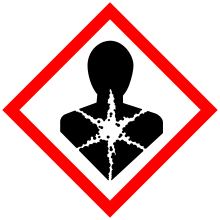Heptadecane
| | |
 | |
| Names | |
|---|---|
| IUPAC name
Heptadecane[1] | |
| Other names
n-Heptadecane[2] | |
| Identifiers | |
| 629-78-7 | |
| 3D model (Jmol) | Interactive image |
| 3DMet | B00353 |
| 1738898 | |
| ChEBI | CHEBI:16148 |
| ChemSpider | 11892 |
| ECHA InfoCard | 100.010.100 |
| EC Number | 211-108-4 |
| KEGG | C01816 |
| MeSH | heptadecane |
| PubChem | 12398 |
| RTECS number | MI3550000 |
| |
| |
| Properties | |
| C17H36 | |
| Molar mass | 240.48 g·mol−1 |
| Appearance | Colorless liquid |
| Odor | Odorless |
| Density | 777 mg mL−3 |
| Melting point | 21.1 to 22.9 °C; 69.9 to 73.1 °F; 294.2 to 296.0 K |
| Boiling point | 301.9 °C; 575.3 °F; 575.0 K |
| Vapor pressure | 100 Pa (at 115 °C) |
| Henry's law constant (kH) |
180 nmol Pa−1 kg−1 |
| Refractive index (nD) |
1.436 |
| Thermochemistry | |
| 534.34 J K−1 mol−1 | |
| Std molar entropy (S |
652.24 J K−1 mol−1 |
| Std enthalpy of formation (ΔfH |
−481.9–−477.1 kJ mol−1 |
| Std enthalpy of combustion (ΔcH |
−11.3534–−11.3490 MJ mol−1 |
| Hazards | |
| GHS pictograms |  |
| GHS signal word | DANGER |
| H304 | |
| P301+310, P331 | |
| EU classification (DSD) |
|
| R-phrases | R65 |
| Flash point | 149 °C (300 °F; 422 K) |
| Related compounds | |
| Related alkanes |
|
| Except where otherwise noted, data are given for materials in their standard state (at 25 °C [77 °F], 100 kPa). | |
| | |
| Infobox references | |
Heptadecane is an organic compound, an alkane hydrocarbon with the chemical formula C17H36. The name may refer to any of 24894 theoretically possible structural isomers, or to a mixture thereof.
The unbranched isomer is normal or n-heptadecane, CH3(CH2)15CH3. In the IUPAC nomenclature, the name of this compound is simply heptadecane, since the other isomers are viewed and named as alkyl-substituted versions of smaller alkanes.
The most compact and branched isomer would be tetra-tert-butylmethane, but its existence is believed to be impossible due to steric hindrance. Indeed, it is believed to be the smallest "impossible" alkane.[3]
References
- ↑ "heptadecane - Compound Summary". PubChem Compound. USA: National Center for Biotechnology Information. 16 September 2004. Identification and Related Records. Retrieved 4 March 2012.
- ↑ Morrison, Robert T.; Boyd, Robert N. (1983). Organic Chemistry (4th ed.). Newton, MA: Allyn and Bacon, Inc. p. 88. ISBN 0-205-05838-8.
- ↑ K. M. de Silva and J. M. Goodman (2005). "What Is the Smallest Saturated Acyclic Alkane that Cannot Be Made?". J. Chem. Inf. Model. 45: 81–87. doi:10.1021/ci0497657. PMID 15667132.
External links
- List of plant species containing heptadecane, Dr. Duke's Phytochemical and Ethnobotanical Databases
This article is issued from Wikipedia - version of the 9/24/2016. The text is available under the Creative Commons Attribution/Share Alike but additional terms may apply for the media files.